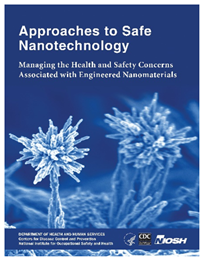Looking to the Past and the Future of NIOSH Nanotechnology Guidance
Posted on byNIOSH has been at the forefront of research on engineered nanomaterials since the early 2000’s. As the NIOSH Nanotechnology Research Center (NTRC) celebrates its 20th anniversary, we look back over two decades of NIOSH NTRC published guidance to help reduce worker exposures to engineered nanomaterials (ENMs). Both companies and workers use this guidance to keep workers safer. NTRC research has led to improved recommendations for controlling exposures during advanced manufacturing processes. Organizations have also used our guidance to base global standards.
Here, we reflect on how our guidance and publications have evolved through decades of research. We also discuss the needs for future research efforts.
The NTRC Strategic Plan
In 2005, NIOSH became the first government agency to publish a strategic plan as a roadmap for nanotechnology research. This work, titled Approaches to Safe Nanotechnology: An Information Exchange with NIOSH, led to seminal guidance for the nanotechnology industry.
The strategic plan served multiple purposes. It offered a chance to collect safety and health concerns about nanomaterial exposures. It also outlined research needs and gave recommendations for workplace practices. International organizations and others used those workplace practices to create guidance documents. In 2009, the strategic plan was updated and published as, Approaches to Safe Nanotechnology: Managing the Health and Safety Concerns Associated with Engineered Nanomaterials.
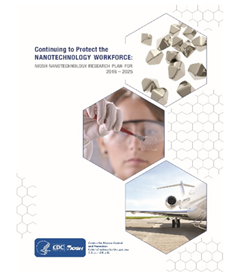 To protect the nanotechnology workforce, NIOSH published the Strategic Plan for NIOSH Nanotechnology Research and Guidance in 2010. Updated in 2014 and 2019, the plan currently describes the NTRC strategy into 2025.
To protect the nanotechnology workforce, NIOSH published the Strategic Plan for NIOSH Nanotechnology Research and Guidance in 2010. Updated in 2014 and 2019, the plan currently describes the NTRC strategy into 2025.
The strategic plan includes filling knowledge gaps in these priority areas:
- Researching the toxicology of available nanoparticles on the market
- Studying long-term effects of carbon nanotubes
- Developing exposure limits and control recommendations for fine and ultrafine titanium dioxide and carbon nanotubes
- Finding new nanomaterials coming into the market for mass production
Establishing Workplace Exposure Limits and Recommendations
Occupational exposure limits are the “gold standard” for those working in occupational safety and health. NIOSH recommended exposure limits (RELs) are intended to prevent adverse health effects in workers from occupational inhalation exposures for up to a 10-hour shift, 40-hour work week, over a working lifetime. Researchers develop RELs from the best science available for a given material.
NIOSH was the first U.S. government agency to establish RELs for ENMs. In 2011, for the first time in its history, NIOSH released two RELs for the same chemical based on fine and ultrafine sizes. These were published in Current Intelligence Bulletin 63: Occupational Exposure to Titanium Dioxide. Workplace guidance recommendations were also provided in this Current Intelligence Bulletin.
NIOSH also published two other ENM-related guidance documents:
- Current Intelligence Bulletin 65: Occupational Exposure to Carbon Nanotubes and Nanofibers (2013)
- Current Intelligence Bulletin 70: Health Effect of Occupational Exposure to Silver Nanomaterials (2021)
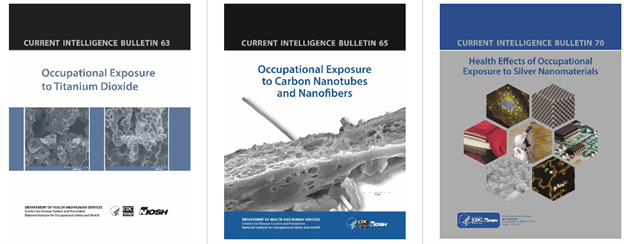
Targeted Guidance for Employers
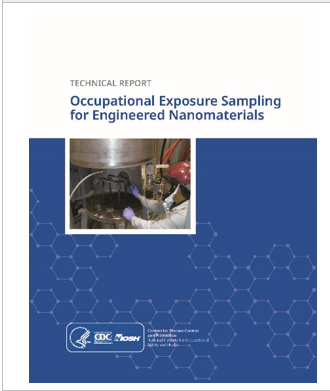 In addition to exposure limits, employers need to know the best workplace practices to meet exposure targets. NIOSH has published guidance documents for these employers:
In addition to exposure limits, employers need to know the best workplace practices to meet exposure targets. NIOSH has published guidance documents for these employers:
- Medical Screening and Hazard Surveillance for Workers Potentially Exposed to Engineered Nanoparticles offers interim guidance on controlling exposures with practical measures, conducting hazard surveillance, and using established medical surveillance methods (2009).
- General Safe Practices for Working with Engineered Nanomaterials in Research Laboratories addresses ENM handling in research laboratory settings (2012).
- Strategies for Engineering Controls in Nanomaterial Production and Downstream Handling Processes helps to find and describe methods for controlling ENM exposures using engineering controls (2014).
- Building a Safety Program to Protect the Nanotechnology Workforce is targeted to small- and medium-sized businesses (2016).
- Occupational Exposure Sampling for Engineered Nanomaterials offers workplace sampling guidance for carbon nanotubes and nanofibers, silver, titanium dioxide, and other ENMs without exposure limits (2022).
Targeted Guidance for Employees
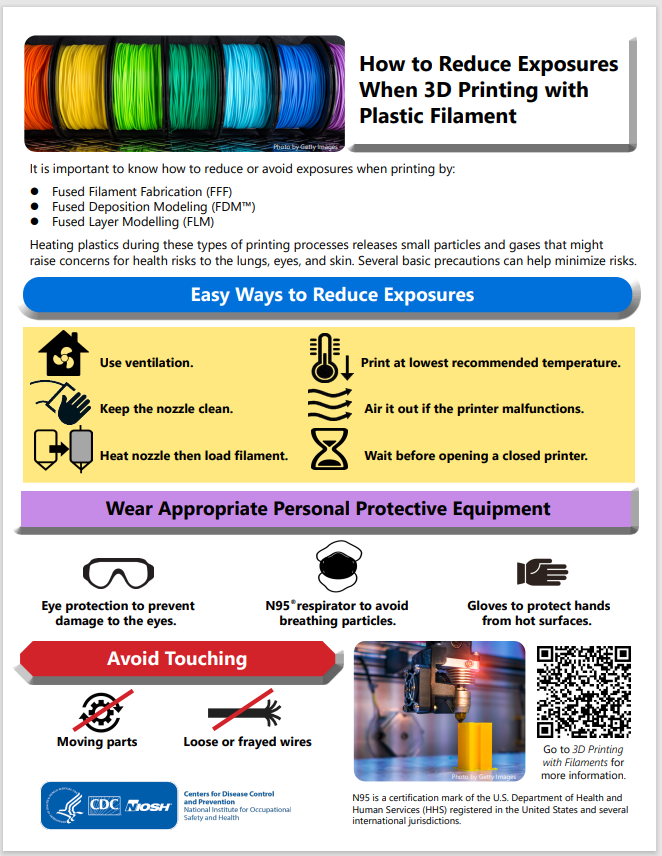 Ultimately, NIOSH aims to protect the health of the worker. When workers understand why and how to manage their exposures, they are more likely to take actions to protect their health. NIOSH published clear, concise, one-page guidance documents specifically for workers.
Ultimately, NIOSH aims to protect the health of the worker. When workers understand why and how to manage their exposures, they are more likely to take actions to protect their health. NIOSH published clear, concise, one-page guidance documents specifically for workers.
For example, three NIOSH posters present safety questions workers should ask before working with nanomaterials and when 3D printing with filament or metal powders. The posters can help workers in recognizing possible hazards. The posters include the types of controls and personal protective equipment workers could use to protect themselves.
NIOSH also published an infographic on reducing exposures when 3D printing with plastic filament. It highlights easy ways to reduce exposures during fused filament fabrication, fused deposition modeling, and fused layer modeling.
Looking Ahead to the Future
NIOSH NTRC remains committed to offering research-based guidance to meet the needs of the ever-changing field of nanomaterials and related emerging technologies. Researchers have recently published Approaches to safe 3D printing: a guide for makerspace users, schools, libraries, and small business to help control exposures. They are also laying the groundwork to develop additional occupational exposure limits for ENMs.
NIOSH continues to seek and gather feedback from the advanced manufacturing industry and provide guidance. The aim is to bridge knowledge gaps and make actionable recommendations. If you have input or suggestions about guidance or research needs, contact nano@cdc.gov or leave a comment below.
You can find a full list of NIOSH nanotechnology publications at Nanotechnology Guidance and Publications.
Jay Vietas, PhD, CIH, CSP, is the Co-Manager of the Nanotechnology Research Center (NTRC) and Branch Chief of the Emerging Technologies Branch in the NIOSH Division of Science Integration.
Lilia Chen, MS, CIH, is the Coordinator of the Nanotechnology Research Center (NTRC) and Deputy Branch Chief of the Emerging Technologies Branch in the NIOSH Division of Science Integration.
This blog is part of a series to commemorate the 20th anniversary of the Nanotechnology Research Center. Click here for additional blogs in the series and on other nanotechnology topics.
Posted on by


